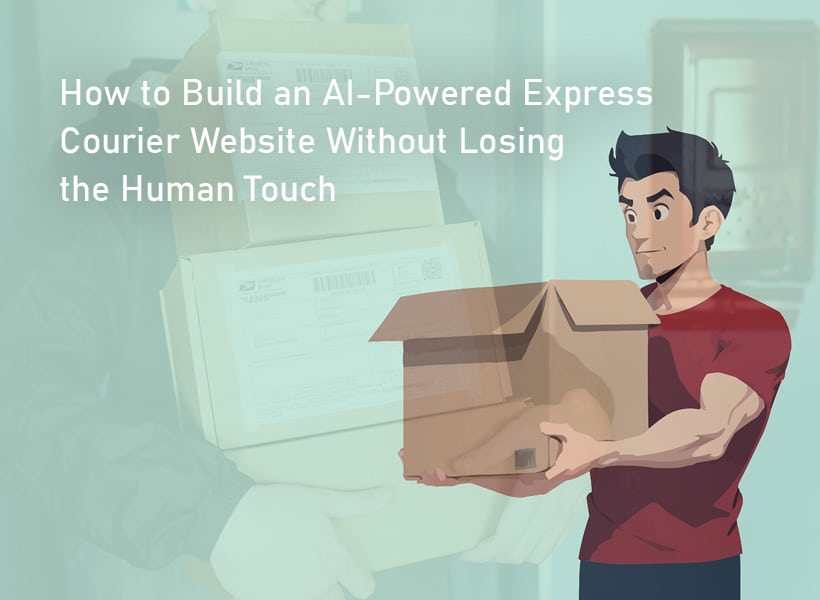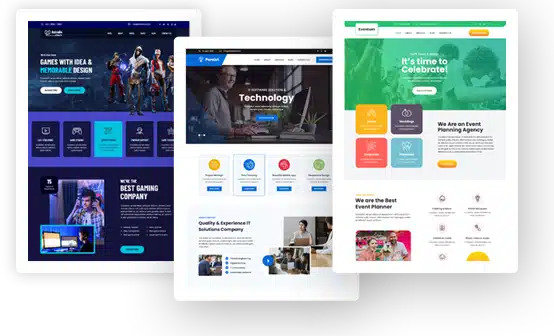How to Build an AI-Powered Express Courier Website Without Losing the Human Touch

In just a couple of years since the rollout of ChatGPT, AI has quite simply changed the world. It has quickly become the technology of the 21st century, and as you can guess, it is now shaking up the courier world.
Specifically, it’s helping courier companies improve their websites (or create new ones) with new features like instant quotes, automated tracking, and predictive delivery.
But there’s a catch: automation can feel cold. Customers still want to feel like they matter, not like they’re interacting with a machine of a brand. That’s why it’s important to humanize AI work, so it gives you that efficiency boost but still feels personal.
So, the sweet spot to aim for is: a courier website that’s powered by AI for speed, but still feels human at every touchpoint. In this guide, we’ll break down exactly how to do it, step by step.
Step 1: Clarify Your Website’s Core Purpose & Audience
Before you start adding AI features left and right, get clear on what your site is actually meant to do—and who it’s meant to serve.
Are you targeting small e-commerce businesses that need bulk shipping? Local customers who just want same-day delivery in their city? Or maybe enterprise clients who expect detailed tracking and invoicing?
Your audience will decide what matters most. For example:
- Small business owners might value instant quotes and label printing.
- Regular consumers might just want a smooth booking process and friendly updates.
- Enterprise clients may prioritize bulk order tools and integration with their own systems.
This clarity will help you decide which parts to automate with AI and which to keep human. A simple rule: let AI handle the repetitive tasks, and let people handle the moments that build trust.
Step 2: Map the Key AI Features to Include
Once you know who you’re building for, it’s time to pick the AI tools that will actually make a difference. The last thing you want is to bloat your website with unnecessary shiny features that nobody uses or cares about.
Your (likely) best bet is to opt for these:
- Instant Quote Generator: AI calculates delivery costs on the spot, factoring in location, weight, size, and urgency. No waiting, no phone calls.
- Automated Tracking Updates: AI sends real-time tracking info and predicted ETAs through SMS, email, or WhatsApp. Customers stay informed without having to ask.
- Chatbot for FAQs & Booking: A friendly, natural-sounding bot that can answer simple questions, guide bookings, and hand off to a human when needed.
- Dynamic Route Optimization: AI finds the best delivery routes in real time, cutting time and fuel costs.
- Fraud Detection: Flags suspicious shipments or payments so you can review them before things go wrong.
The key here is to pick features that remove friction for customers and save time for your team. Everything else is just tech for tech’s sake.
Step 3: Keep the Human Touch in the Design & Experience
Customers are on your website to do business, but if they are dealing with a soulless machine, you’ll lose them.
Warm and human is what you want your company to be at every touchpoint, which requires:
- Using friendly, human language. Even your AI chatbot should sound like a helpful person, not a script.
- Making it easy to reach a real human. One click to switch from bot to live chat or a phone call (no endless loops).
- Adding human oversight to AI decisions. Let staff review flagged shipments, high-value orders, or delivery exceptions.
- Designing for comfort, not just function. Clean layouts, relatable images, and no overwhelming jargon.
Think of AI as your silent assistant. It handles the busywork, but the customer should always feel like you are the one taking care of them.
Step 4: Choose the Right Tech Stack & Tools
Your website is only as good as the tools running it. So you need to pack a stack that can handle both your AI features and your express courier operations without turning into a maintenance nightmare.
Here’s an AI-first sample stack you can consider:
- Website Platform:
- WordPress with AI-ready plugins if you want flexibility and control.
- Custom React/Vue build for speed and scalability.
- Shopify if you’re combining courier services with e-commerce.
- AI Integrations:
- Dialogflow or OpenAI API for chatbots and instant quotes.
- TensorFlow for route optimization and predictive delivery.
- Logistics APIs:
- ShipEngine, EasyPost, or direct DHL/FedEx APIs for shipping rates and tracking.
- Customer Support & CRM:
- Zendesk or Freshdesk for live chat, ticketing, and AI-assisted support.
Choose tools that play well together. The more your systems talk to each other, the smoother the experience for your customers.
Step 5: Integrate AI Into Your Operations Workflow
AI on your website is great. But if it’s not connected to the rest of your operations, it’s just a flashy front end.
Your goal is a smooth chain from customer click to driver delivery. That means:
- Sync AI tools with your driver app. If a customer gets an updated ETA, the driver’s app should update instantly, too.
- Connect tracking to inventory and dispatch. No manual data entry between systems.
- Automate routine alerts. Let AI send “out for delivery” or “delayed” messages so your team can focus on problem-solving.
- Centralize data. Every update, whether from AI or a human, should live in one system.
When AI is part of your full workflow, customers get consistent updates, and your team avoids the “sorry, I’ll have to check” moments.
Step 6: Test the Balance Between Automation & Empathy
AI can overstep boundaries or hallucinate things. You need to make sure it’s helping, not frustrating, your customers.
Start small. Roll out one or two AI features, then watch how people use them. Ask questions like:
- Did they get their answer quickly?
- Did the AI feel helpful or robotic?
- Did they still feel taken care of?
Use mini surveys, feedback forms, and even quick follow-up calls to find out. If customers are bailing out of the chatbot too soon, maybe it’s too stiff.
If they’re still calling for quotes, your instant pricing tool might not be visible or helpful enough.
AI should speed things up without making customers feel like they’re on their own. When in doubt, lean toward empathy over automation.
Step 7: Train Your Team for AI-Human Collaboration
AI is only half the equation. Your team needs to know how to work with it, not against it.
So, teach them the handoff. When a chatbot escalates a case, staff should step in seamlessly, knowing exactly what’s already been said.
Show them how to read AI data. Delivery predictions, fraud alerts, and customer history should be reviewed before speaking to the customer. Encourage personal follow-ups. A quick call after a delayed delivery can turn a bad experience into a loyal customer.
When your people trust the AI firepower you bring in—and customers trust your people—you’ve nailed the balance.
Wrapping Up
AI can make your courier website faster, smarter, and easier to use. But speed alone doesn’t win customers.
The sweet spot is simple: Let AI handle the repetitive work. Let people handle the moments that matter.
When you combine the two, you get a site that’s efficient without feeling cold. Customers get quick answers and genuine care. Your team works faster without losing the personal touch.
That’s not the future of courier service, it’s the here and now.

